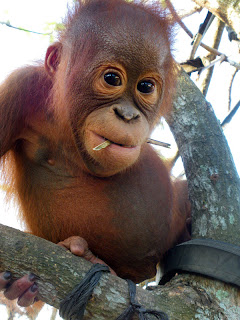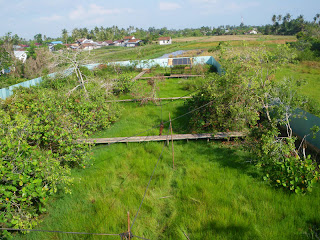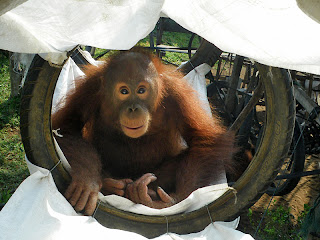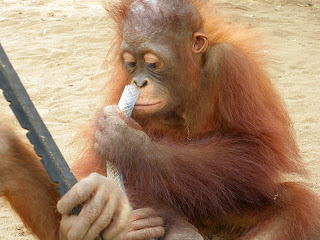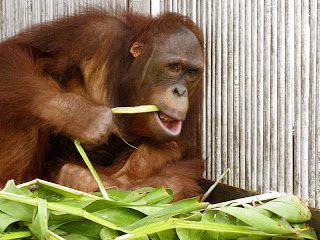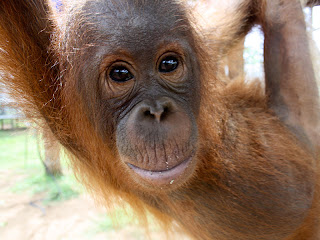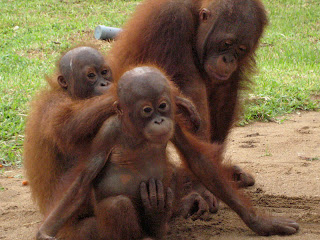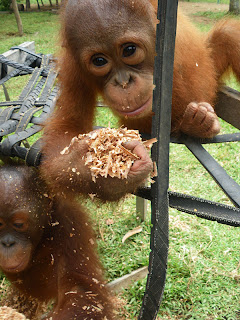 Paloma updates us on how our rescued orangutans are enjoying their enrichment programme at International Animal Rescue's orangutan centre in Ketapang, West Kalimantan.
Paloma updates us on how our rescued orangutans are enjoying their enrichment programme at International Animal Rescue's orangutan centre in Ketapang, West Kalimantan.Every day the orangutans enjoy a different part of the monthly environmental enrichment programme. One of these enrichments is made with sawdust which they love to play with and also, if we add some nuts and seeds, they will spend time foraging for them. It is very interesting to see the reactions of the different orangutans to the enrichment, depending on their various personalities.

At the baby school, we put the sawdust in a bucket which is placed between two hammocks. After filling the bucket to the brim with sawdust the curious ones soon come to investigate and examine it. They carefully remove the sawdust in small handfuls, but normally one of them gets very excited and has a wild game with the bucket and the sawdust. The last time Sindi took the lead. She hurried over when she saw the rest cautiously investigating the bucket, and then she was so excited that she jumped straight into it!
Then she climbed out again, landing on the grass but at the same time holding on to the bucket and trying to knock it over, which she eventually succeeded in doing. Then Sindi started to cover her head and her face with the sawdust and was clearly having the time of her life!

Karmilla, who is normally very shy with the enrichment and doesn’t engage very often, was there too and her fur was full of the sawdust because of Sindi's game. The other orangutans were completely surprised by Sindi's reaction: they just watched her and occasionally tried to join in but she was so focused on the sawdust that she hardly noticed the other orangutans.
The older orangutans at the emergency rescue centre have also enjoyed this enrichment, but in a different way. We usually put the sawdust inside a 19l bottle, adding also some rolled up newspaper and some peanuts and then we put the bottle inside the enclosure.
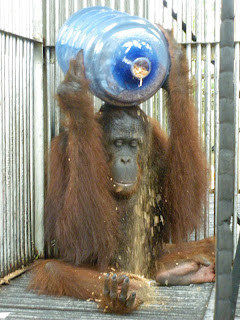
I have seen different reactions to this enrichment: for example, the first thing Monte does is get the newspaper out of the bottle. But when he gets it out he doesn’t do anything with it. He tips the bottle up and watches the sawdust falling, then he tries to catch the peanuts that are falling with the sawdust.
However, his enclosure mate Patrick has found a better way to get the peanuts: he gets the newspaper that Monte takes out from the bottle and spreads it out on the floor of the enclosure, then he gets the bottle and lets the sawdust fall on the newspaper, so the peanuts can’t fall through the bars onto the ground below.
I have also seen this technique used by the group of Jojo, Jingo and John, but in this group, Jojo is the one who manipulates the bottle, letting the sawdust fall onto the newspaper, while Jingo and John are watching and waiting for the moment when the peanuts appear and then they quickly snatch them!

After finding all the peanuts they all remove every bit of sawdust from their fur and also spend a lot of time just playing with the empty bottle.
This kind of enrichment is excellent as occupational entertainment because it encourages the orangutans to forage and explore new textures. It also stimulates them to think of the best ways to get the peanuts that are hidden in the sawdust. And clearly they all have a lot of fun too!
 IAR volunteer Paloma Corbi tells us about the worrying condition of the latest baby orangutan to be brought into our centre.
IAR volunteer Paloma Corbi tells us about the worrying condition of the latest baby orangutan to be brought into our centre.









